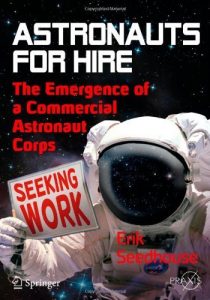'Astronauts For Hire' is a comprehensive and authoritative study of the increasing need for commercial astronauts. Erik Seedhouse provides unique insights into the burgeoning new field of commercial space operation and the individuals who will run these missions.
Section I begins by describing how Astronauts for Hire (A4H) was created in 2010 by Brian Shiro, a highly qualified NASA astronaut candidate, and a group of other astronaut candidates. Erik introduces A4H's vision for opening the space frontier to commercial astronauts and describes the tantalizing science opportunities offered when suborbital and orbital trips become routine.
Section II describes the vehicles astronauts will use. Anticipation is on the rise for the new crop of commercial suborbital and orbital spaceships that will serve the scientific and educational market. These reusable rocket-propelled vehicles are expected to offer quick, routine, and affordable access to the edge of space, along with the capability to carry research and educational crew members. The quick turnaround of these vehicles is central to realizing the profit-making potential of repeated sojourns by astronauts to suborbital and orbital heights.
Section III describes the various types of missions this new corps of astronauts will fly and who will hire them. For example, suborbital flights may be used to do high altitude astronomy, life science experiments, and microgravity physics. This section continues with an examination of the types of missions that will accelerate human expansion outward, to Exploration Class missions through lunar bases, the establishment of interplanetary spaceports, and outposts on the surface of Mars. Along the way it describes the tasks commercial astronauts will perform, ranging from mining asteroids to harvesting helium.
Section I begins by describing how Astronauts for Hire (A4H) was created in 2010 by Brian Shiro, a highly qualified NASA astronaut candidate, and a group of other astronaut candidates. Erik introduces A4H's vision for opening the space frontier to commercial astronauts and describes the tantalizing science opportunities offered when suborbital and orbital trips become routine.
Section II describes the vehicles astronauts will use. Anticipation is on the rise for the new crop of commercial suborbital and orbital spaceships that will serve the scientific and educational market. These reusable rocket-propelled vehicles are expected to offer quick, routine, and affordable access to the edge of space, along with the capability to carry research and educational crew members. The quick turnaround of these vehicles is central to realizing the profit-making potential of repeated sojourns by astronauts to suborbital and orbital heights.
Section III describes the various types of missions this new corps of astronauts will fly and who will hire them. For example, suborbital flights may be used to do high altitude astronomy, life science experiments, and microgravity physics. This section continues with an examination of the types of missions that will accelerate human expansion outward, to Exploration Class missions through lunar bases, the establishment of interplanetary spaceports, and outposts on the surface of Mars. Along the way it describes the tasks commercial astronauts will perform, ranging from mining asteroids to harvesting helium.






